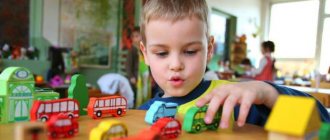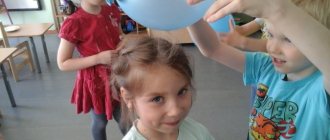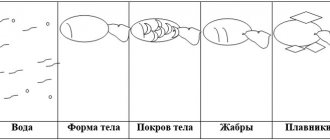Methods and techniques for organizing research activities
Topics of research activities for preschool children:
- Science fiction – topics related to the study of fantastic, non-existent objects and phenomena.
- Empirical – topics that require independent experimentation and observation.
- Theoretical - topics that are focused on organizing work on the study of certain materials and facts, their analysis and generalization.
Rules for choosing a topic for research activities for preschoolers:
- the topic should be interesting to children;
- the topic should be understandable and accessible for children to understand and study;
- the topic must have real benefits for the research participants in terms of their development, education and training;
- the theme requires an element of unusualness and surprise;
- the topic involves relatively quick execution and obtaining the final result.
Methods and techniques for organizing research activities of preschool children:
- heuristic conversation;
- formulation and subsequent solution of a specific problematic issue or situation;
- different types and types of observations;
- modeling situations;
- various experiences;
- recording the results obtained during experiments, observations, experiments and other activities;
- immersion in a problematic situation;
- artistic word;
- gaming activities: different types of games, creative situations, etc.;
- work assignments and actions.
Organization of research activities of children in preschool institutions
Children are explorers by nature. Research, search activity is the natural state of a child, he is determined to understand the world around him, he wants to know it: he tears the paper and sees what happens; watches the fish in the aquarium, studies the behavior of the tit outside the window, conducts experiments with various objects; disassembles toys, studying their structure. All of these are objects of research. Exploratory behavior for a preschooler is the main source of gaining ideas about the world.
A preschool child is already a researcher in himself, showing a keen interest in various types of research activities, in particular experimentation. By older preschool age, the possibilities of search and research activities aimed at “discovering” new things, which develop productive forms of thinking, increase noticeably. In this case, the main factor is the nature of the activity.
In the process of experimentation, the child needs to answer not only the question of how I do this, but also the questions of why I do it this way and not otherwise, why I do it, what I want to know, what to get as a result.
Currently, certain aspects of children's experimentation are reflected in the works of N. N. Poddyakov, A. N. Poddyakov, O. V. Dybina, I. E. Kulikovskaya, N. N. Sovgir, A. I. Savenkov, O. V. Afanasyeva.
The originality and types of children's experimentation (N. N. Poddyakov), the features of variable search of preschoolers in conditions of operating with multifactorial objects (A. N. Poddyakov) were studied, the possibilities of organizing experimentation in kindergarten were considered (O. V. Dybina, L. N. Prokhorova , I. E. Kulikovskaya, N. N. Sovgir).
Science owes the introduction of the term “experimentation” to J. Piaget: he analyzed the significance of this activity for children and adolescents and proved that the advantage of children’s experimentation lies in the fact that it gives real ideas about the various aspects of the object being studied, about its relationships with other objects.
The most important feature of experimentation, according to N.N. Poddyakov, is that in the process of its implementation a person acquires the ability to control this or that phenomenon: to cause or stop it, to change this phenomenon in one direction or another.
To date, the methodology for organizing children's experimentation has not been fully developed - experimentation is being introduced into the practice of preschool institutions slowly.
In the 1990s, professor, academician of the Academy of Creative Pedagogy of the Russian Academy of Education N. N. Poddyakov, having analyzed and summarized his rich experience of research work in the preschool education system, came to the conclusion that in childhood, in addition to play, the leading activity is experimentation. The use of this teaching method was advocated by such famous teachers as J. A. Komensky, I. G. Pestalozzi, J.-J. Russo, K.D. Ushinsky and many others.
Goals and objectives of experimental research activities
Goal: Development of cognitive activity, curiosity, desire for independent knowledge and reflection in preschool children
Tasks:
- Expanding children's horizons through familiarization with elements of various fields of knowledge (ideas about the chemical properties of substances, physical properties and phenomena, the properties of water, sand, clay, air, mathematical concepts, etc.)
- Developing in children the ability to use assistant devices when conducting experimental games (microscope, magnifying glass, cup scales, hourglass, etc.)
- Formation of mental abilities in children: development of analysis, classification, comparison, generalization
- Formation of ways of knowing through sensory analysis
- Social and personal development: development of communication, independence, observation, basic self-control and self-regulation
Classification of children's experimentation
- By the nature of the objects used in the experiment: experiments: with plants; with animals; with objects of inanimate nature;
- At the location of the experiments: in a group room; Location on;
- The reason for their implementation: random, planned, in response to a child’s question.
- By the number of observations of the same object: single, multiple, or cyclic
- By the number of children: individual, group, collective.
- By the nature of inclusion in the pedagogical process: episodic (conducted from case to case), systematic
- By duration: short-term (5–15 min.), long-term (over 15 min.)
- According to the nature of children’s cognitive activity: illustrative (children know everything, and the experiment only confirms familiar facts), search (children do not know in advance what the result will be), solving cognitive problems;
- By place in the cycle: primary, repeated, final and final;
- By method of application: demonstration, frontal;
- By the nature of mental operations: ascertaining (allowing you to see one state of an object or one phenomenon without connection with other objects and phenomena), comparative (allowing you to see the dynamics of a process or note changes in the state of an object), generalizing (experiments in which general patterns of the process being studied are traced earlier in separate stages).
Features of organizing children's experimentation in preschool educational institutions
- The experiment should be short in duration.
- It is necessary to take into account that it is difficult for preschoolers to work without speech accompaniment (since it is in older preschool age that children go through the stage of pronouncing their actions out loud).
- It is also important to take into account the individual differences of children (pace of work, fatigue).
- It is necessary to take into account the child’s right to make mistakes and use adequate ways to involve children in work, especially those who have not yet developed skills (dividing one procedure into several small actions assigned to different children, joint work of the teacher and children, help from the teacher to children, work of the teacher in instructions from children, the teacher’s conscious assumption of inaccuracies in work, etc.).
- When working with children, you should try not to draw a clear line between everyday life and learning, because experiments are not an end in themselves, but a way of getting to know the world.
- It is also necessary to take into account the age characteristics of children
Creating conditions for children's experimentation
In the experimental activity corner (mini-laboratory, science center) the following should be highlighted:
‒ a place for a permanent exhibition where a museum, various collections, exhibits, rare objects (shells, stones, crystals, feathers, etc.) are located
‒ space for devices
‒ a place to store materials (natural, “waste”)
‒ a place for conducting experiments
- place for unstructured materials (sand, water, sawdust, shavings, polystyrene foam, etc.)
- diagrams, tables, models with algorithms for performing experiments
‒ a series of paintings depicting natural communities
‒ educational books, atlases, thematic albums
- simple devices
‒ collections
‒ mini-museum (themes vary, for example, “ Clocks ” )
‒ materials divided into sections: “Sand, clay, water”, “Sound”, “Magnets”, “Paper”, “Light”, “Glass”, “Rubber”
‒ natural materials: stones, shells, saw cuts and leaves of trees, moss, seeds, different types of soil, etc.
‒ waste materials: pieces of leather, fur, fabric, plastic, wood, cork, etc.
‒ different types of paper: plain, cardboard, sandpaper, copy paper, etc.
- medical materials: pipettes with rounded ends, flasks, wooden sticks, measuring spoons, rubber bulbs, syringes without needles
- other materials: sieve, funnels, halves of soap dishes, ice molds, magnifying glasses, microscope, hourglass, magnifying glass, children’s personal notebooks for recording the results of the experiment
- weight measures: various scales, a set of weights; length: meter, rulers, conventional measurements; volume: measuring cups, jugs, spoons, etc.; time: hourglass, stopwatch; quantities: various abacus; directions: compass.
- for playing with water, snow, ice: filters made of paper, gauze, mesh; paints of different colors, saturated saline solution for obtaining salt crystals, growing crystals on twigs; various molds for freezing water, means for blowing soap bubbles, various vessels with narrow and wide necks, funnels, various homemade boats made of paper and nutshells
‒ for playing with light: mirrors, flashlights, means for changing the color of a flashlight signal, a candle
‒ for playing with a magnet, glass, rubber: magnet, objects made of various materials, bouncy figures, balls
Technology for organizing joint experimental and research activities with preschool children
- Statement of the research problem in the form of a problem situation.
- Clarification of the research plan.
- Selection of equipment, placement of it independently (or with the help of an adult) by children in the research area.
- Distribution of children into subgroups (at the request of the children), selection of leaders who help organize peers.
- Organization of the study.
- Analysis and generalization of the experimental results obtained by children
Methods and techniques
- Questions from the teacher that encourage the formulation of a problem, helping to clarify the situation and understand the meaning of the experiment; stimulating the child’s self-esteem and self-control, which determine success in cognition: “ Are you satisfied with yourself as a researcher?”
- Schematic modeling of experience; examination of experimental diagrams, tables, simplified drawings.
- A method that encourages children to communicate “ Ask... what he thinks about this?” " .
- “ method of applying the results of one’s own research activities.
- Problem situations, for example, “Why was there snow yesterday, but not today?”, “The reason for the appearance of steam when breathing.”
- Experimental games.
- Actions with a magnet, magnifying glass, measuring instruments, transfusion of liquids.
- Observation of natural phenomena.
- Use of encyclopedias.
To maintain interest in cognitive experimentation, you can use:
‒ Real events: striking natural phenomena and social events.
‒ Events specially “ modeled ” by the teacher: the introduction into a group of objects with an unusual effect or purpose, previously unknown to children, arousing genuine interest and research activity (“What is this? What to do with it? How does it work?”). Such items could be a magnet, a collection of minerals, or clipping illustrations on a specific topic.
‒ Imaginary events occurring in a work of fiction that the teacher reads or reminds the children (for example, a balloon flight of the characters in N. Nosov’s book “The Adventures of Dunno and His Friends”).
‒ The stimulus for research can be events occurring in the life of the group, “infecting” most of the children and leading to fairly stable interests (for example, someone brought his collection, and everyone, following him, became interested in dinosaurs, stamps, collecting beautiful stones and so on.).
‒ Organizing joint experiments and research with children in everyday life. Organization of children's experimentation and research in the process of observing living and inanimate objects and natural phenomena.
Forms of interaction with parents of students:
‒ Questionnaire of parents
‒ Involvement in creating a cognitive and developmental environment in the group, assistance in setting up an experimentation corner, replenishing the necessary materials
‒ Design of visual information in the parent’s corner: consultations, memos, recommendations: “Spend time with your children at home,” “How to organize conditions for research activities of preschoolers,” etc.
‒ Parent meetings, at which parents learn about the form of organizing research work, get acquainted with research teaching methods, and a variety of experiments.
‒ Open events for parents.
‒ Design of the “My discoveries” folder, thematic sliding screens, exhibitions, mini-libraries, etc.
‒ Experimentation of parents with children at home.
‒ Joint creativity between children and adults (making baby books, designing albums, posters, photo reports, etc.).
‒ Joint child-adult cognitive and research activities. In conditions of close interaction with the family in the group, the following studies can be prepared and conducted: “The house in which I live”; “Portrait of Spring”, “Autumn is a delicious time of year”, “Summer, oh summer”, “What do I know about air”, etc. (reading, observations, excursion, experiments).
Thus, in the work on experimental research activities of preschool children, it is necessary to use different forms and methods in a complex, and correctly combine them with each other. The choice of methods and the need for their integrated use is determined by the age capabilities of preschoolers, the nature of the educational tasks that the teacher solves.
The effectiveness of solving problems in experimental research activities depends on their repeated and variable use. They contribute to the formation in preschoolers of clear knowledge, skills and abilities about the world around them.
The mastery of systematized search-cognitive knowledge of children, the formation of experimental actions forms the foundations of logical thinking, ensures maximum efficiency of the intellectual development of preschoolers and their full readiness for learning at school.
Literature:
- Dybina O.V., Rakhmanova N.P., Shchetina V.V. The unknown is nearby. M., 2004
- Ivanova A.I. Children's experimentation as a teaching method./ Preschool educational institution management, N 4, 2004
- Kulikovskaya I.E., Sovgir N.N. Children's experimentation. Senior preschool age. — M.: Pedagogical Society of Russia, 2003
- Organization of experimental activities for preschool children. / Edited by L. N. Prokhorov M., 2004
- Parshukova I. L. Conducting research classes in kindergarten; spatial developmental environment in kindergarten. Principles of construction, advice, recommendations / comp. N.V. Nishcheva. - St. Petersburg, “Childhood-press”, 2006.
- Ryzhova N. A. Developmental environment of preschool institutions (From work experience). M., LINKA-PRESS, 2003.




